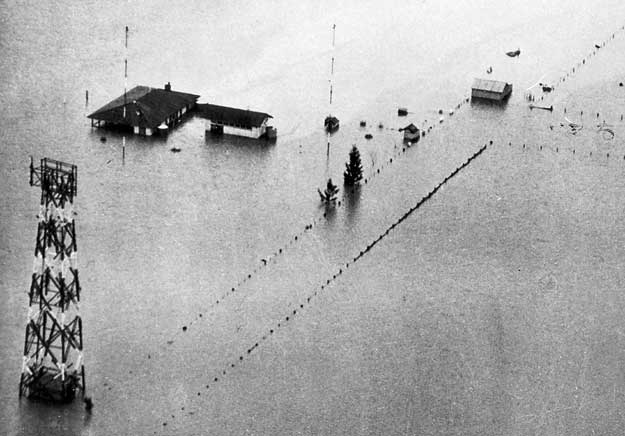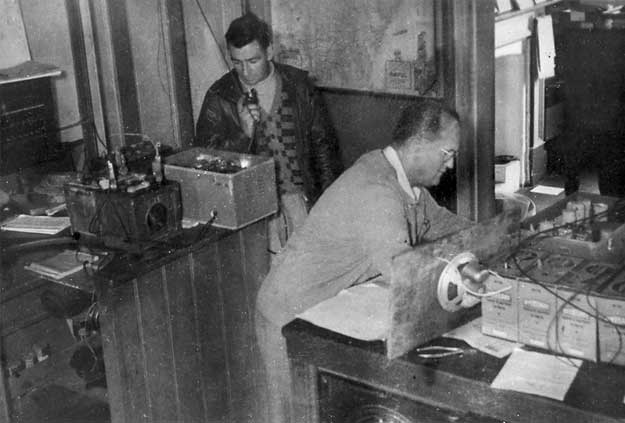
Situated
on the northern New South Wales coast on the banks of the Macleay River, Kempsey
was one of the original twelve Aeradio
stations constructed in 1938 by AWA Ltd for the Civil
Aviation Branch.
In 1949 a disastrous flood struck the town and the aerodrome and Aeradio facilities were inundated. The photo above shows the Aeradio station and adjoining Power House, HF receiver masts and, at lower left, the 33 Mc Lorenz Radio Range antenna tower.
Arthur Lindeman, who retired as Airport Manager, Canberra, was stationed at Kempsey from 1945 to 1949 and recalled: "Kempsey Airport supported an intermittent Anson aircraft service to and from Sydney and a Sunderland flying boat service to Taree, Port Macquarie and Grafton with road connections to Kempsey. One of the pilots was the noted aviation pioneer P. G. Taylor, later Sir Gordon Taylor.
"Kempsey Aeradio provided communication between Brisbane and Sydney on a point-to-point Morse channel, with aircraft overflying Kempsey on a 24-hour basis. One of the prime navigational aids used by aircraft was a 33Mc Radio Range located on the airport, an NDB (non directional beacon) and a rotating light.
"Staff comprised five Aeradio operators, covering three shifts, at a salary range of £120-£378, plus sixpence a mile for vehicles and one penny per mile for bicycles to and from the airport.
"The area around Kempsey Airport was noted for its colonies of large black snakes and violent thunderstorms. It could hardly be considered relaxing on 'doggo' [night] shifts to be isolated with an electrical storm overhead or sitting there estimating the length of the snakes as they moved over the ceiling joists.
"On Friday, 26 August 1949, I started duty at midnight. During the night 360 points of rain fell. By 2 am the rain was 'bucketing' , down and I explained the situation to the Flight Checking Officer at Sydney and requested permission to close the station. A regular freighter was due out of Brisbane about this time and permission was refused.
"At about 3.30 am the wife of a local farmer and her young son arrived and asked if I had been outside lately. The water was lapping the top steps, a depth of about four feet. Equipment which could be moved was placed as high as possible after advising Sydney and Brisbane that the station was closing. With all transmitters, navigational aids etc switched off we headed for the high ground across the airport. Dawn was breaking.
"The
passage through a set of 12 feet wide double gates narrowed to what felt like
12 inches as we passed through the centre point eyeing off the snakes which had
coiled themselves round the fencing wires and gate posts.
"The next
three days were spent with the farming families from the area and it was pitiful,
particularly on the Saturday when a further 827 points of rain fell, to witness
houses, outhouses and belongings being washed down the river. Kempsey Airport
communication and navigational facilities were never fully restored. Coffs Harbour
then provided the services to aircraft in that area."

Communications
with the outside world were restored when the Aeradio men set up an emergency
332 HF transmitter in the Kempsey Police Station, as seen in the photo above.
The operators are Charles Peddell (left) and J Pickles. Charles Peddell was later
awarded a Certificate of Merit by the NSW Commissioner of Police for his work
on restoring communications during the flood.
(Photos: Top-Sydney Morning Herald/CAHS collection; bottom-CAHS collection)
Back to the main Air Traffic Services index